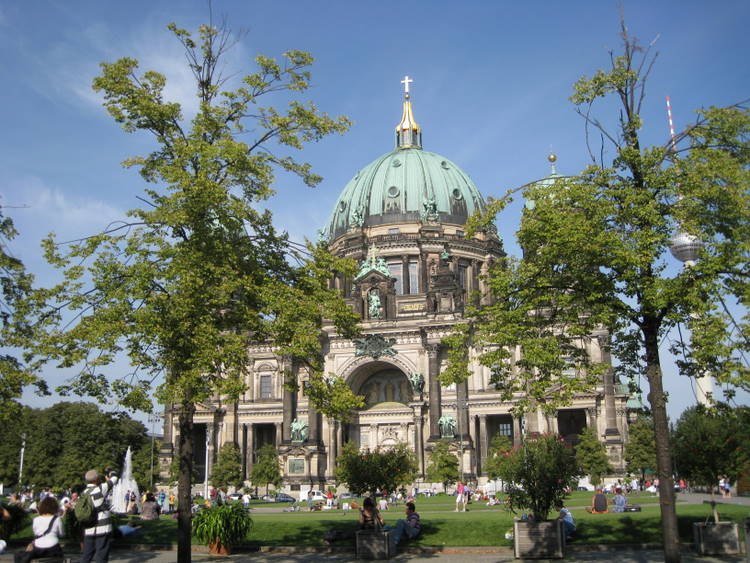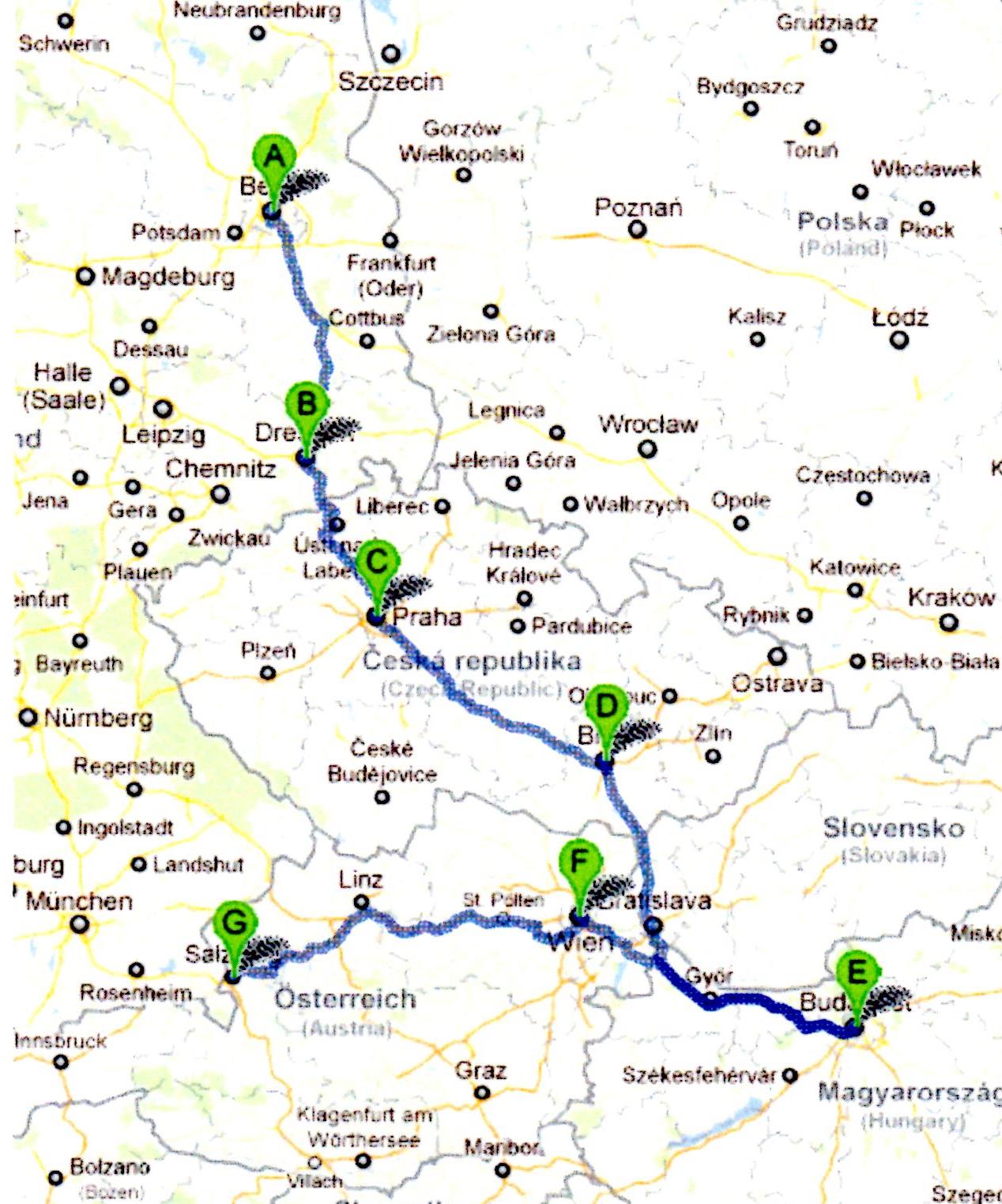CENTRAL EUROPE
2011
Day
2
September
3
Saturday
BERLIN
We
slept over 12 hours last night. We
didn’t wake up until almost 7:30. We
had granola, yogurt, a ham and cheese croissant and a pastry in our apartment.
Our apartment kitchen was well furnished
including a dishwasher , but no coffee pot. There was an electric tea
kettle and packs of instant coffee. We
asked about it at the front desk and they said they didn’t have any coffee
pots. I guess we will have to use
instant coffee, at least for a starter for the next few days.
BERLIN
We
have anticipated for months our visit to Berlin during which we have read a lot
about the tragic history of this wonderful town.
Berlin received very heavy damage during World War I, but nothing
compared to the devastation of the city and the lives of its inhabitants during
World War II. It always seems
unbelievable that Hitler could have caused so much destruction in the world.
One of the readings that I “enjoyed” before our trip was a series of
four novels by David Downing written about an English journalist who lived in
Berlin from 1936 to 1945. The books
were named after metro stations: Zoo
Station, Silesian Station, Stettin Station and
Potsdam Station. He graphically
describes what it was like to live in Berlin during the Nazi reign.
My wife read a series by Jonathan Rabb about life during World War I
beginning with a book called “Rosa”.
Then
there was, of course, the period during the Cold War with the Berlin Wall
separating East and West Berlin. We
found many symbols of reconciliation throughout Berlin, in fact, in all of the
cities that we visited as they were all victims of the war and their citizens
unmercifully slaughtered. One could
write many pages about the history of Berlin, but many more capable authors have
done that, so I will leave more details to them.
So,
having recovered some from our flight, we start out on an exciting adventure to
explore as much of Berlin that we can in a four days.
We
left our apartment about 9:00 AM, and walked about a block to the Hackescher
Market S-bahn station and caught the tram to the next stop and changed for
another tram that took us to the Brandenburg
Gate. Berlin has a wonderful transportation system.
There is the S-bahn which are the trains/trams that run above ground and
the U- bahn which are underground. Plus
there are buses and regular street trains.
We
had to walk a couple of blocks to the Brandenburg gate. It
was spectacular. I am anxious to
make my model.
BRANDENBURGER
TOR ( BRANDENBURG GATE)
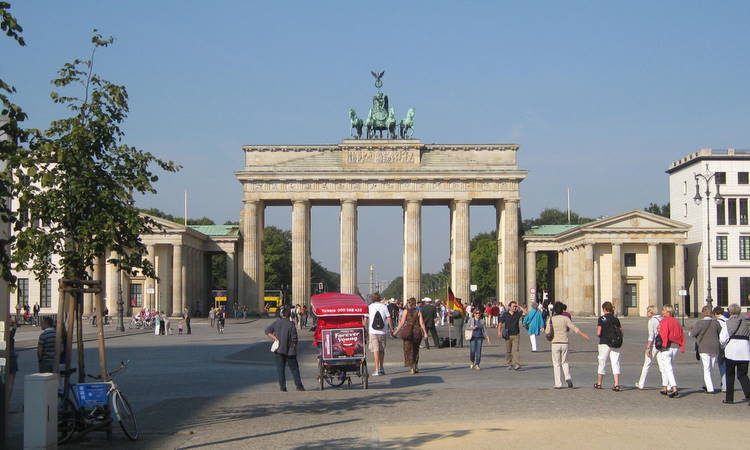 The Brandenburg Gate was begun in 1788 and finished three years later.
It was built as arch of peace. It
was modeled after the entrance to the Acropolis temple in Athens.
A sculpture of the goddess Viktoria and her ch
The Brandenburg Gate was begun in 1788 and finished three years later.
It was built as arch of peace. It
was modeled after the entrance to the Acropolis temple in Athens.
A sculpture of the goddess Viktoria and her ch ariot
on the top was stolen by Napoleon in 1806 but later returned.
During the time of the Berlin Wall, it stood in No Man’s Land.
ariot
on the top was stolen by Napoleon in 1806 but later returned.
During the time of the Berlin Wall, it stood in No Man’s Land.
Not
far from the gate is the Reichstag. We
came upon the right side and walked around the front to the tour office. My
reservation queen wife had requested the tour several
months before. Then they had emailed
wanting other identification and finally sent the passes.
As with most things that we visit on our cathedralquest, reservations
must be made well in advance of the visit.
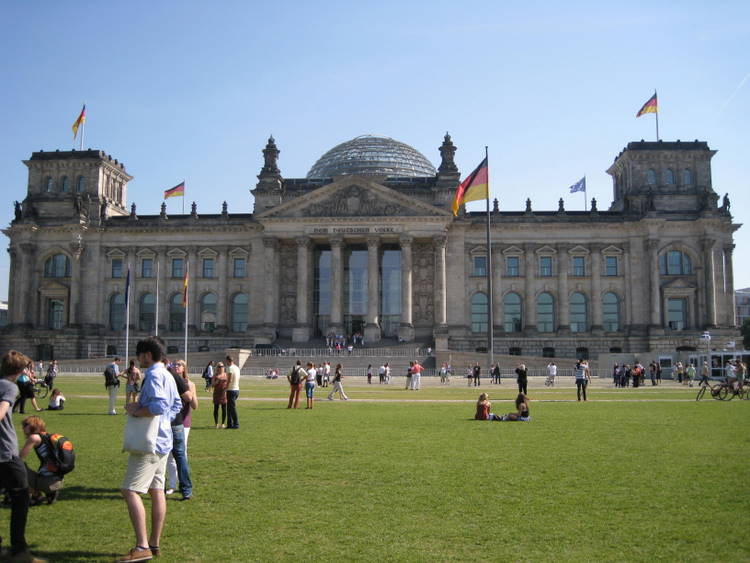 The
Reichstag is Germany’s parliament building.
It was built in the 1890s by Kaiser Wilhelm II, the last German emperor.
It was from this building that the German Republic was proclaimed in
1918.
The
Reichstag is Germany’s parliament building.
It was built in the 1890s by Kaiser Wilhelm II, the last German emperor.
It was from this building that the German Republic was proclaimed in
1918.
In
1933 the Reichstag nearly burned down. While
the Nazis blamed a communist plot, some believe that Hitler himself planned the
fire, using it as an excuse to frame the communists and grab power.
As World War II
drew to a close, Stalin ordered his troops to take the Reichstag from the Nazis.
On April 30, 1945 the
building fell to the Russians.
It
was little used from 1933 to 1999. In
1995 the British architect Norman Foster rebuilt it
into the new parliamentary home of the Bundestag (Germany’s lower house). 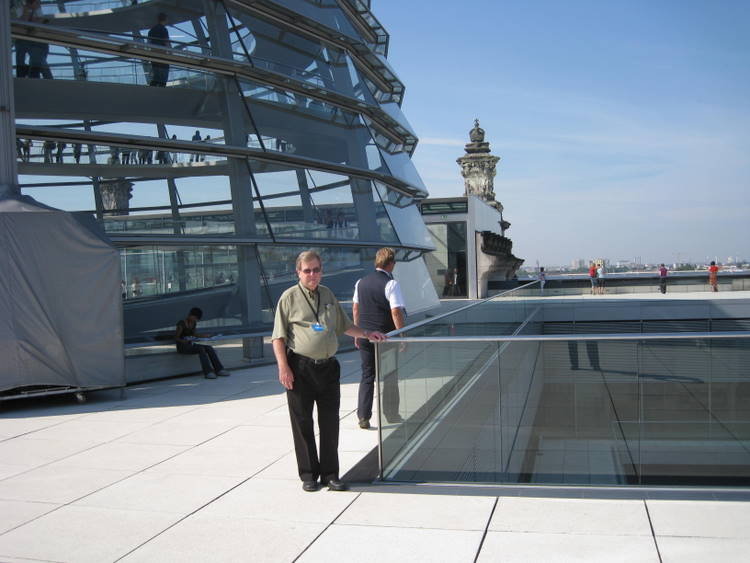
After
going through a lot of security, we were taken to a room inside and told that we
had about a half hour before our tour and we could go to the dome (the glass
cupola). 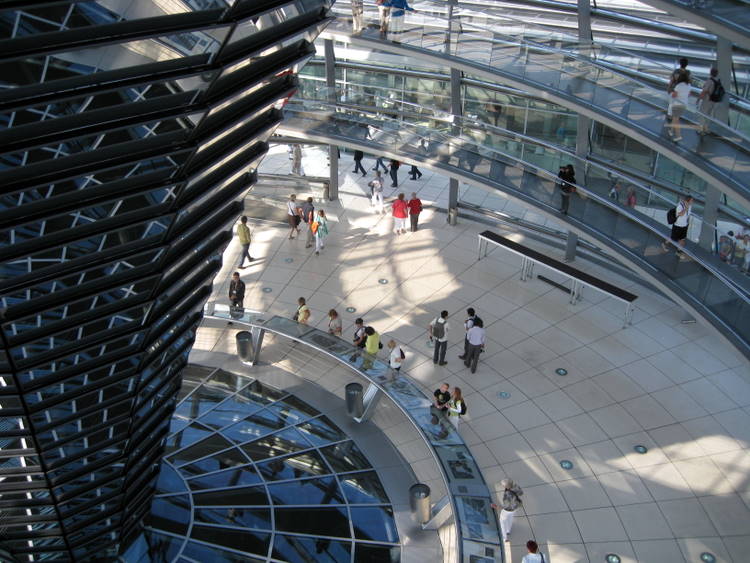
This
dome rises 155 feet above the ground. Inside
are two ramps that spiral 755 feet to the top.
After getting off of the elevator from the waiting area below, everyone
receives an audio guide. As
you walk up the ramp, the guide points out various locations and buildings in
Berlin that can clearly be seen as you walk up.
Inside the dome is a cone consisting of 360 mirrors which reflect light
into the legislative chamber below. 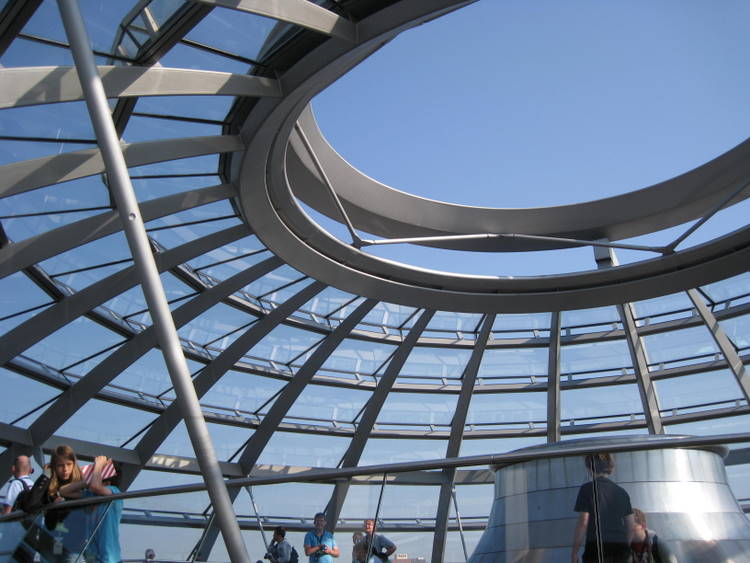
It
also aids in the heating and air conditioning. I went up to the top while my
wife preferred to watch me from below. Then we went down stairs and joined a
small group of people from various countries for an English speaking hour.

The
hour-long tour, with an excellent guide took us to all the important areas of
the building. In the lower floors,
they had preserved the names and some graffiti that had been writing on the
walls by the “liberating” Russians in 1945.

The
tour ended with us being seated in the gallery of the central legislative
chamber. All of the seats had been
covered in a lilac-blue material. Afterwards
we were allowed to go back up to the dome.
There is a restaurant on the top but we purposely had not made
reservations for lunch.
The
whole experience was very interesting. I
would strongly suggest that the Reichstag is a must for those visiting Berlin
for the first time. Remember to
request your tour via email and get your tickets MONTHS in advance.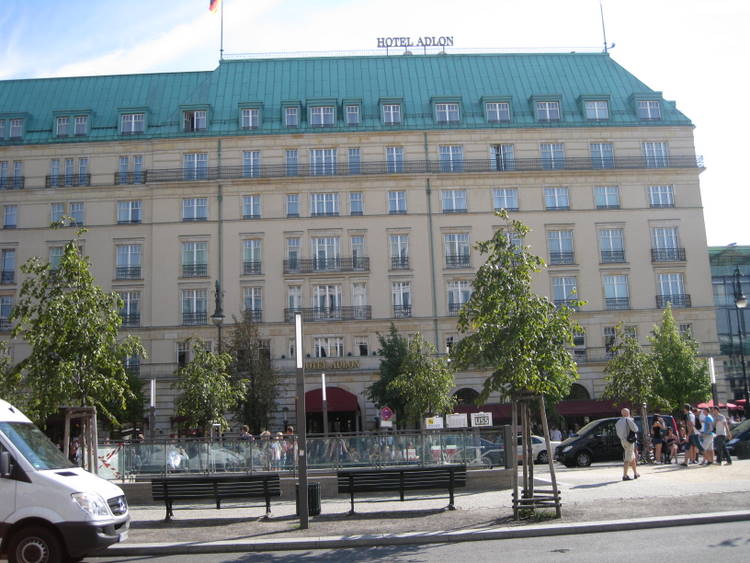
SEE MY MODEL OF THE REICHSTAG.
We walked around the outside of the Reichstag and took a lot
of photos. I am anxious to match the
real details with my model. We
walked several blocks before we got back to the Unter den Linden – the main
street that leads to the Brandenburg Gate. We
decided to have lunch in the outdoor café of the Aldon Hotel.
I had read a lot about the Aldon Hotel in the David Downs WWII series. It
was where the journalists hung out. The
Adlon, built in 1907, was one of the most famous hotels in Europe between the
two World Wars and hosted many celebrities. The hotel survived the war without
any major damage, having avoided the bombs and shelling that had leveled the
city. However, on the night of May
2,1945 a fire started in the hotel's wine cellar by intoxicated Soviet soldiers
that left the main building in ruins. It
was finally demolished in 1984 and rebuilt in 1997.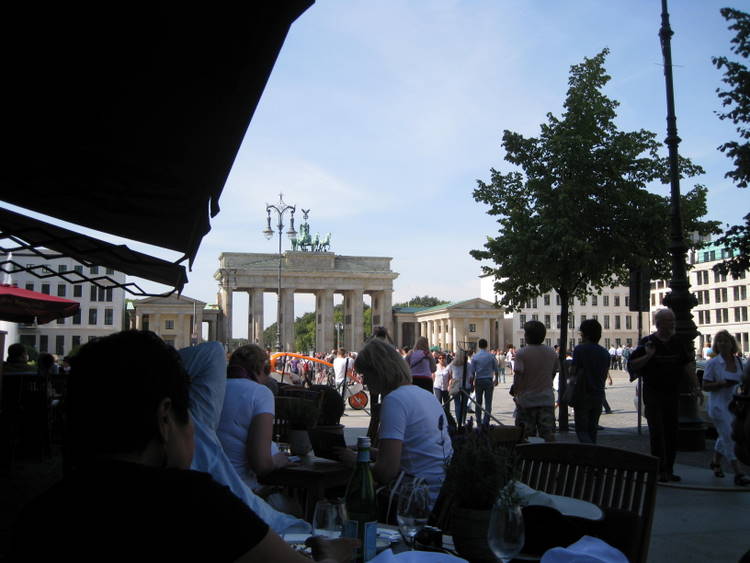
The
lobby is very attractive as is the dining room.
We choose to sit in the outdoor café which was right on the side walk of
the Unter den Linden. We had a
wonderful view of the Brandenburg Gate. I
had delicious calves liver and mashed potatoes and my wife had Char fish.
It was interesting to watch all the crowds go by.
You would have thought you were in D.C.
People looked no different. Teenagers
with their torn blue jeans, back packs and cell phones.
Next
we went to the memorial for the murdered Jews of Europe.
It is located on the street behind the Aldon Hotel.
It was very most moving.
THE
MEMORIAL TO THE MURDERED JEWS
The
Memorial to the Murdered Jews is the Holocaust memorial for Germany.
It has its origins in citizens’ initiative that was facilitated by
journalists Lea Rosh and historian Eberhard Jackel at the end of the 1980’s.
On June 25, 1999, the German Federal Parliament made the decision to
build the memorial according to a design by Jewish American Peter Eiseman.
Construction began on April 1, 2003 and was completed on May 12, 2005.
The
memorial consists of a Field of Stalae (upright blocks) covering almost 1 ½
acres and containing 2,711 blocks plus an information c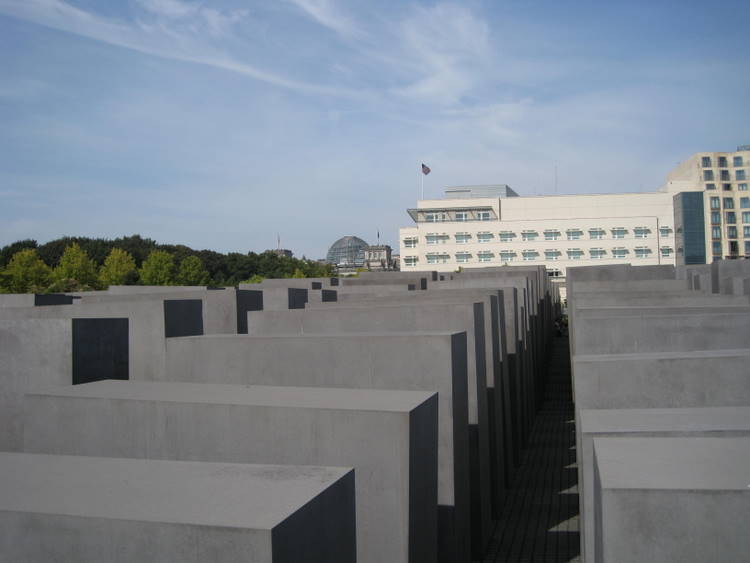
enter.
The Stalae were of various heights. The
purpose was to walk through all of these stones on paths that were slanted or
hilly. Often the blocks were so high
that you had a sense of being captured by them.
It was like being in a maze. It was a very emotional experience, almost
to the point of being disorientated.
On
one side was an entrance to the underground area which consisted of a long wall
which was an overview of the national-socialist terror policy between 1933 and
1945. The graphic photographs dealt
with the persecution and murder of European Jews.
It too was very moving. We
were impressed by the large number of young people moving along this display.
The next room, called the Room of Dimensions, featured diary entries,
letters and last notes written by victims of the Holocaust.
Next
we entered the Room of Families where the lifestyles of 15 families, before and
during the Holocaust, were shown. The
final room was the Room of Names where the names of all the victims were being
read. It was said that it would take
six years, seven months and 27 days to read the names of all of the victims.
We
would encourage all of you who visit Berlin to visit this memorial to this
terrible and needless tragedy.
We
walked back toward the Aldon hotel and went across the street where I had a
Hagan Das ice 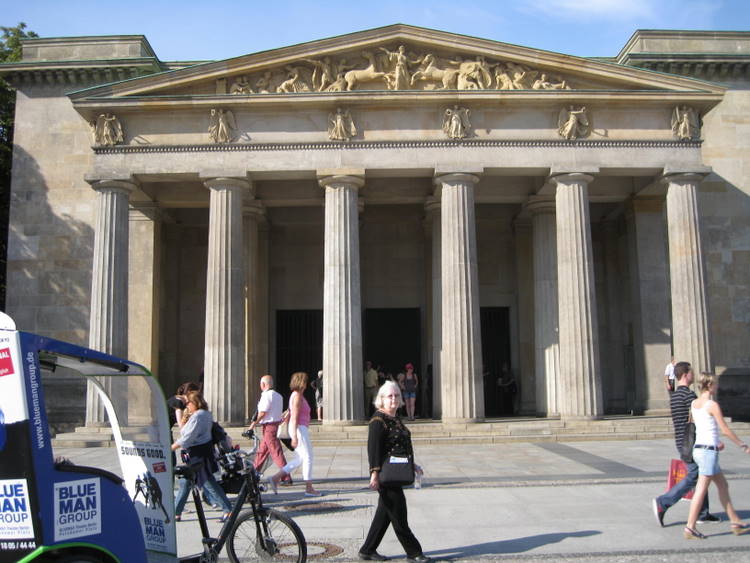
cream,
and my wife found a Starbucks. We
start walking in the opposite direction of the Brandenburg Gate on Unter den
Linden which contained some shops and the German History Museum, which we
planned to visit later but never made it.
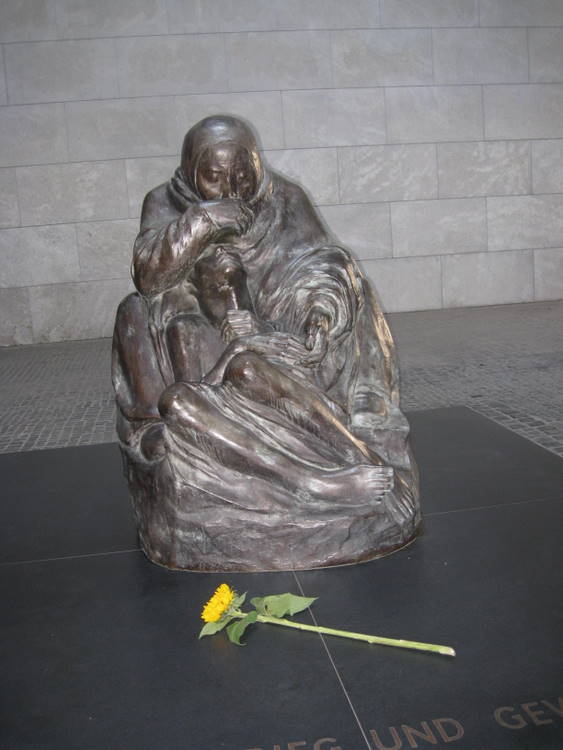
We
passed the German State Opera on the other side of the street.
It was undergoing some major restoration, and we could not see the
complete façade. Near the Humboldt
University was a Greek temple like building known as NEUE
WACHE (the emperor’s “New Guardhouse”, from 1816).
When the Berlin Wall fell, this memorial to the victims of fascism was
transformed into a new national memorial. Inside
there is a large empty room with a replica of the Kathe Kollwitz statue, Mother
with Her Dead Son. This marks
the tombs of Germany’s unknown soldier and the unknown concentration camp
victim.
We
walked a little further until we came to the Berlinerdom.
It is located next to the Museum Island, which we will visit another day
and the Spree River. Having spent
many hours making the model, it was breathtaking seeing it in person.
I took many photos of the parts that I had spent so much time on.
The
Berlinerdom, which is Berlin’s Protestant cathedral, was the fourth Berlin
cathedral built on this spot. Kaiser
Wilhelm II laid the foundation of the present church in 1894.
It was consecrated in 1905. The
Berlinerdom was damaged as far down as the crypt in an air-raid on May 24, 1944.
A bomb set fire to the dome which falls into the main part of the church
and through the floor to the crypt below. Apart from some makeshift repairs, the
ruin was left to its fate until 1975 when an extensive rebuilding program began.

Unlike
cathedrals in other cities where the surrounding buildings made it impossible to
take a photograph of the entire building, the
Berlinerdom has a large grassy area in front.
People enjoyed these grounds and the lovely fountain in the middle.
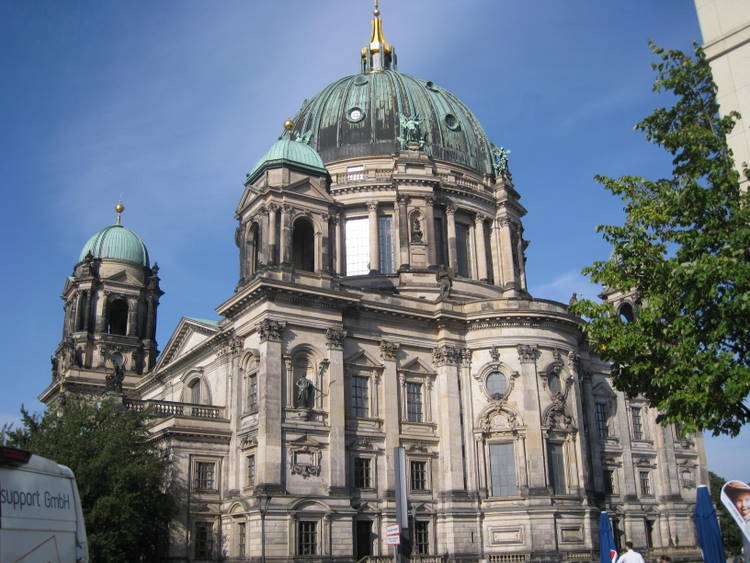
The
backside of the Dom sits on the bank of the river which offers a number of views
both from across the bridge and from a river cruise, which we took later.
The
Berlinerdom does not have the appearance of any other cathedral that we have
ever visited. In fact, if one
didn’t know it was a church, at first glance it would not appear to be so.
There is a similar architectural similarity between the Reichstag and the
Berlinerdom. The style is Baroque or
some call it Neo-Renaissance. It
is almost square in design except for a small apse that extends on the river
side. One of the first parts that one notices is the dome.
It is 377 feet high. On each corner of the building are towers with
domes. The front two are larger than
those on the back.
 To
enter the church, there are a number of steps to climb.
Sections of the steps are now being replaced.
The center section has a large rounded arch, with a fresco on the upper
side. Over the door is a large
mosaic. It was designed by Arthur
Kampf in the 1920’s. The words
under it say: “Come to me, all you who
are weary and burdened, and I will give you rest.”
The figures represent the blind, sick, lame, and man wearing a steel
helmet from WWI.
To
enter the church, there are a number of steps to climb.
Sections of the steps are now being replaced.
The center section has a large rounded arch, with a fresco on the upper
side. Over the door is a large
mosaic. It was designed by Arthur
Kampf in the 1920’s. The words
under it say: “Come to me, all you who
are weary and burdened, and I will give you rest.”
The figures represent the blind, sick, lame, and man wearing a steel
helmet from WWI.
There
are two openings on either side of the main arch.
Between the exterior and the front wall of the church runs an arcade the
entire width of the cathedral.
We
had to pay to go inside and were told that we only had a short time before it
closed. Photos without flash were
allowed. The organist for practicing
for the Sunday service. 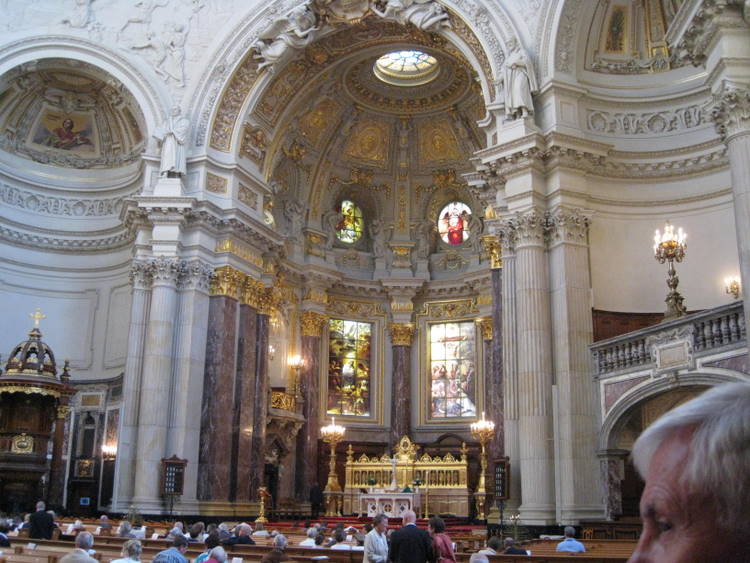
In
keeping with the outside dimensions the interior was square with an open dome in
the center. The entire interior was
very Baroque with a rounded arches , fluted columns with decorated capitols. Eight
life size statues of Protestant Reformers stood on top of each column.
These included Martin Luther, John Calvin and Ulrich Zwingli.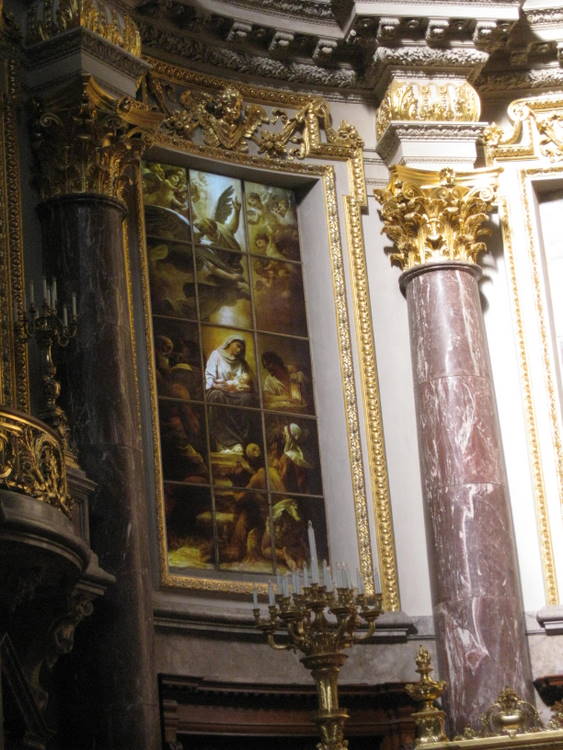
The
sanctuary area in the apse was decorated with rich brown marble walls and gold
accents. Three large stained glass
windows were behind the altar. These
were replacement windows as the original had been destroyed during the bombing.
These windows were not like the stained glass found in most churches.
The figures was painted so
the sunlight could 
shine
through, rather than small pieces of glass.
It was around 5:00 PM when we were there and the windows were hard to
see.
On
the left wall was a tremendous organ.
The
dome was in mos
aics
with the eight panels depicting the Beatitudes.
The
attendant at the door appeared to be anxious to lock the doors and we wanted to
go to the crypt and bookstore. We
planned on returning tomorrow for the Sunday service.
We
went down to the crypt
which held a number of elaborate tombs of noted persons of history including
several kings and queens. We
didn’t have much time to really study them.
The
bookstore was large and had a lot of resources.
I bought a book about the Dom plus a refrigerator magnet.
The door from the crypt to the bookstore locked from the outside, so we
waited until someone came out and we went back in. We went back upstairs where
we were told it was time to leave.
SEE MY MODEL OF THE BERLINERDOM
We
realized as we were walking towards the Berlinerdom that we weren’t too far
from our apartment. We stopped at
the Radisson Hotel and had a drink. The
center of the hotel contained a fish tank that was 10 stories high.
It was round and from another building people came down inside of the
tank in an elevator device. The bar
surrounded about ¾ of the tank. It
would make someone think that they had had too much to drink when they saw
people in the fish tank with fish swimming around them.
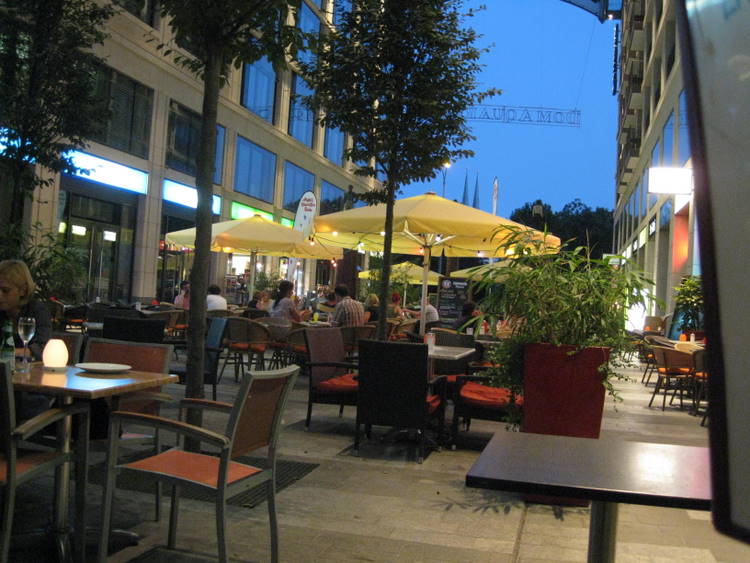
Our
feet were getting tired so we went back to the apartment for a short rest before
hitting the apartment bar. After a
few refreshing drinks in their outdoor café, we walked back toward the Dom
where we had seen a number of restaurants. Half
way between the river and our apartment there was a glass covered street running
off
Unter de Linden which contained a number of eateries, all with outdoor
cafes. We decided on the Piazza Monaco wh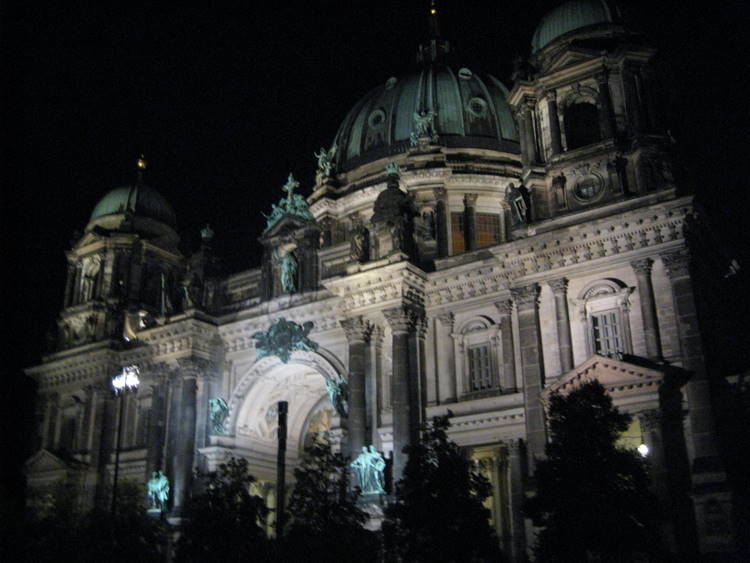
ich
seemed to be the most popular . We
shared a pizza and a salad and wine.
We
walked another block to see the Berlinerdom lit at night. It was beautiful.
Back
home after a very good day.


 ariot
on the top was stolen by Napoleon in 1806 but later returned.
During the time of the Berlin Wall, it stood in No Man’s Land.
ariot
on the top was stolen by Napoleon in 1806 but later returned.
During the time of the Berlin Wall, it stood in No Man’s Land.













